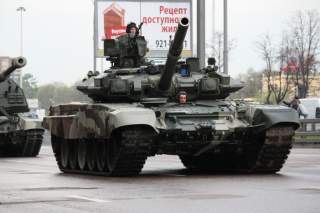Russia's Lethal T-90 Tank vs. ISIS' Captured M1 Abrams: Who Wins?
While it might be a remote possibility, it would be a very interesting match up.
With Russia’s surprise move to deploy ground forces to Syria, the remote possibility that Russian forces might confront Islamic State of Iraq and Syria (ISIS) operated M1A1 Abrams main battle tanks emerges.
According to numerous media reports, the Russian military has deployed a half dozen T-90 main battle tanks, 15 self-propelled heavy artillery pieces and thirty-five infantry fighting vehicles along with about 200 naval infantrymen—basically marines—into the war ravaged nation. The Russian forces appear to be building an airbase as a staging area to bring in additional military supplies for the beleaguered Syrian government.
While the chances of a direct confrontation between Russian forces in the area and ISIS operated armor are fairly remote, there is a small possibility that could happen. ISIS has destroyed or captured a number of the Iraqi Army’s 140 M1A1 SA Abrams tanks. While many of these tanks were destroyed using anti-tank missiles, at least a few were captured and may continue to be operated by the terrorist organization. Most of those Abrams tanks are probably operating in Iraq (if they are still functional), but it’s not completely inconceivable that ISIS might move some into Syria.
(Recommended: NATO's 5 Most Lethal Weapons of War)
So how would ISIS’ Abrams fare versus the best Russian-owned and operated tanks? Probably not very well—the Russian crews are professional soldiers, with proper training, tactics and a functional logistical train. ISIS, meanwhile, might have some veterans of Saddam Hussein’s army, but they aren’t exactly experts at employing an Abrams or even mechanized warfare in general given their past performance.
Unlike in previous encounters between Russian-built hardware and U.S.-built machines, the Soviet-built machines were generally export models that didn’t feature the most advanced equipment. Moreover, crew training, tactics, maintenance, spare parts availability and logistical support may have been subpar—like Saddam Hussein’s army when it faced off against the U.S. Army in the first Gulf War.
(Recommended: Russia's Most Lethal Warplane)
In this case, ISIS’ Abrams would be the export models that were sold to Iraq. While the M1A1 SA has many advanced features, it lacks the heavy depleted uranium armor matrix found on the U.S. Army’s own tanks. Further, the Iraqi Abrams were not equipped with features such as explosive reactive armor that would have helped those vehicles survive in combat against ISIS or other insurgent groups’ anti-tank missiles from various angles. But even then, the Iraqi Army is losing to ISIS not because of its equipment, but because it lacks the discipline, tactics, training and procedures to fight and win.
While ISIS likely has the motivation and discipline to put up a fight, what the group doesn’t have is the logistical train to operate the Abrams. The Abrams is a complex, maintenance intensive machine that requires a steady stream of spare parts and ammunition. Moreover, its 1500hp gas turbine engine also burns fuel at a rapid clip—so a steady supply of JP-8 fuel is a must. At the end of the day, the Abrams is designed to operate as part of a large conventional army—which ISIS is not.
(Recommended: 5 Russian Weapons of War America Should Fear)
ISIS is not a conventional fighting force—in many ways it’s a hybrid between a conventional army and an insurgency. While the group may use armor captured from Iraqi or Syrian stocks, it’s not going to employ tanks in massed armored formations like the U.S. Army or Russia. ISIS doesn’t have enough tanks or the training to undertake such an endeavor even if they can learn to operate an individual Abrams as a vehicle. Fighting as part of a conventional mechanized force is a lot more complicated than just learning operate a single vehicle—it takes a lot of coordination and training.
Overall, if there was an encounter between the Russian T-90s and group of ISIS operated Abrams, it’s likely that a force of trained Russian soldiers would prevail. The problem for the Russians is probably not going to be ISIS tanks but rather the hordes of ISIS soldiers armed with rocket-propelled grenades, anti-tank missiles and explosively formed penetrators that they might face-off against.
Dave Majumdar is the defense editor for The National Interest. You can follow him on Twitter: @DaveMajumdar.
Image: Flickr/Creative Commons.

